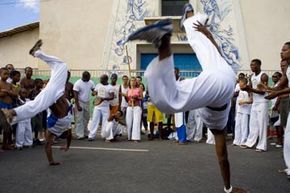Capoeira History
Capoeira (pronounced "cap oh AIR uh") is a mixture of martial arts, dance, acrobatics and tricks initially developed by Africans who were brought to Brazil during the slave trade era -- or it may have originated in Africa and traveled to Brazil with the slaves. The subject is hotly debated, and no one knows for sure [source: Capoeira NYC]. What isknown is that capoeira is an Afro-Brazilian art form, and it was initially used to fight slavery. Capoeira's unexpected attacks and fast, tricky movements, could easily harm the African enslavers, the white masters and other oppressors.
Africans practiced the art and taught it to each other on Sundays, their one day of rest. To ensure the white men didn't realize what they were doing, they began incorporating some of their native music, singing, dance and other rituals so it appeared they were simply having fun, not practicing a potentially harmful martial art [source: Capoeira].
Advertisement
When slavery ended, capoeira was used by criminals in gangs. Eventually it was deemed so dangerous that Brazilian president Marechal Deodoro da Fonseca banned its practice in 1890 [source: Capoeira]. If you were caught performing capoeira, punishment was severe; you might have the tendons at the back of your feet cut, for example. Although these harsh crackdowns nearly wiped out capoeira, it survived, thanks to practitioners' street smarts. To warn of approaching police, for example, a distinctive musical rhythm was developed and played out. And those who practiced capoeira adopted nicknames to hide their true identities from the authorities. Nicknames have become a tradition still in use today [source: Capoeira Universe].
In the early 20th century, a man named Manuel dos Reis Machado, or Master Bimba, created a new style of capoeira that was more effective and efficient in its movements. Master Bimba then convinced authorities capoeira was an important cultural institution, and the ban was ended in the 1930s. Master Bimba opened the first capoeira school in 1932, and he's considered the father of modern capoeira [source: Capoeira NYC].
Today's capoeira game involves two combatants, musicians and an audience that gathers around the two in a circle. There's a strict hierarchy to the musical instruments, with the berimbau, a single-stringed musical bow, the leader. Every rhythm played by the berimbau has a meaning (faster rhythms mean a livelier game, slower rhythms dictate a slower game with more trickery), and the audience claps along. Songs are also sung in a call-and-response pattern between one of the musicians and the crowd; songs might encourage combatants to step up the pace, for example, or ratchet up or down the violence [source: Rensselaer Polytechnic Institute].



